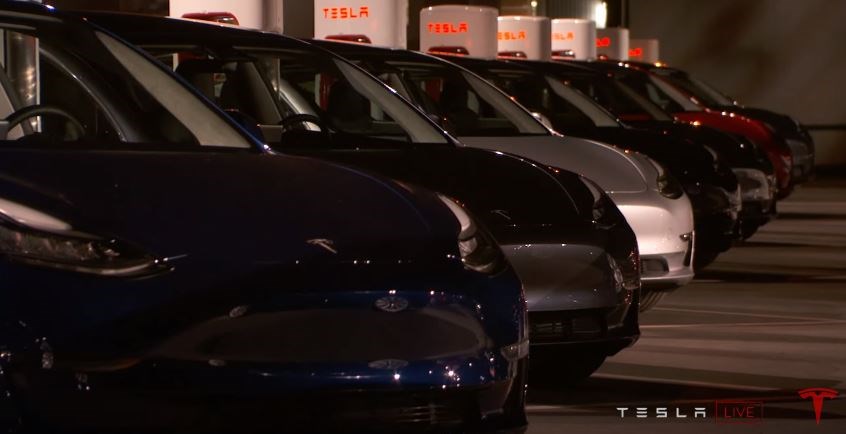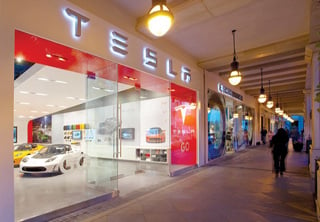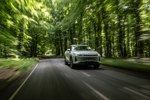Tesla’s Model 3 outsold the BMW 3 Series, Audi A4 and Mercedes-Benz C-Class as it became Europe’s fastest selling electric vehicle (EV) during February.
Within weeks of the arrival of the first shipment of the California-based EV maker’s mid-sized saloon into Zeebrugge, its impact on the sector was felt as the influx of 3,657 vehicles into the market outstripped deliveries of its more established rivals.
Jato Dynamics’ monthly report on the European market revealed Tesla success in a market which was 1.3% down year-on-year at 1.14 million – the region’s sixth consecutive month of decline.
Year-to-date registrations of 2.37 million leave the market 3% down.
Felipe Munoz, Jato’s global analyst, said: “The performance of the Model 3 is remarkable, given we normally don’t see this kind of result until four or five months after a new car has hit the roads.”
Overall, EVs’ market share in Europe remained marginal at 1.9%, but volumes increased by “a huge 92% to 20,000 registrations” in February, Jato reveaed, gaining traction in markets like Norway, where they counted for 40% of overall registrations, and the Netherlands, where they counted for 7%.
 The Model 3 quickly outsold the Nissan Leaf and Renault Zoe last month, despite being a more expensive EV offering, and only available for a short amount of time.
The Model 3 quickly outsold the Nissan Leaf and Renault Zoe last month, despite being a more expensive EV offering, and only available for a short amount of time.
It became the top-selling premium midsize sedan in Europe.
“As we’re seeing in the US, Tesla is also shaking up the European market. Its long-lasting impact will depend on how quickly the German premium makers, Volvo and JLR react to the arrival of the Model 3 to Europe and how quickly they can bring in their own midsize electric cars,” said Munoz.
The UK was one of 12 of the European region’s nations to experience registrations growth in February, its 1.4% rise placing it 11th in the rankings.
 In Spain registrations fell by 10% amongst political turmoil and the Netherlands, where a change in tax on pure electric vehicles contributed to the 15% drop in overall registrations.
In Spain registrations fell by 10% amongst political turmoil and the Netherlands, where a change in tax on pure electric vehicles contributed to the 15% drop in overall registrations.
The Swedish and Finnish markets also saw declines of 15% and 11%, respectively, as the two countries continued to struggle to come to grips with the introduction of WLTP.
Conversely, registrations were up by a huge 36% in Romania, due to the Government’s scrappage scheme in Q4 2018, which led to an increase in vehicle deliveries in Q1.
Denmark also recorded a strong result in February, with volume up by 8% due to an increase in its EV and PHEV registrations.
This was mirrored in Norway, where nearly twice as many zero-emission cars were sold than in February 2018, and the Tesla Model 3 and VW e-Golf were the two best-selling cars.
Diesel registrations fell once again in February, according to Jato’s analysis of the market, although the fuel type’s market share did stabilise at 34%.
This was due to an 8% increase in registrations in Germany, which helped to offset double-digit falls in Italy, France, Spain and the UK, it said.
Volkswagen led the model rankings with the Golf, which saw a decline in its gasoline registrations (down 18%), but an 8% increase in its diesel registrations.

Meanwhile, the Volkswagen T-Roc climbed the rankings to become the best-selling SUV in Europe, outselling the Tiguan and Qashqai.
February was also a good month for the new generations of the Volkswagen Polo, which was Europe’s third best-selling car, and the Ford Focus, which was sixth.
Elsewhere, the Opel Corsa hit the top 10 as its volume increased by 13%, despite its aging model.
Among the latest arrivals to join the Tesla 3 in February, were 3,810 registrations of the Citroen C5 Aircross; 3,657 of the Tesla Model 3; 3,190 of the Peugeot Rifter; 2,110 of the DS 7 Crossback; 1,684 of the VW Touareg; 1,458 of the Audi Q8; 1,368 of the Seat Tarraco; 951 of the Mercedes CLS; 891 of the Jaguar I-Pace; 712 of the Jeep Wrangler; and 431 of the Kia Proceed.




















Login to comment
Comments
No comments have been made yet.